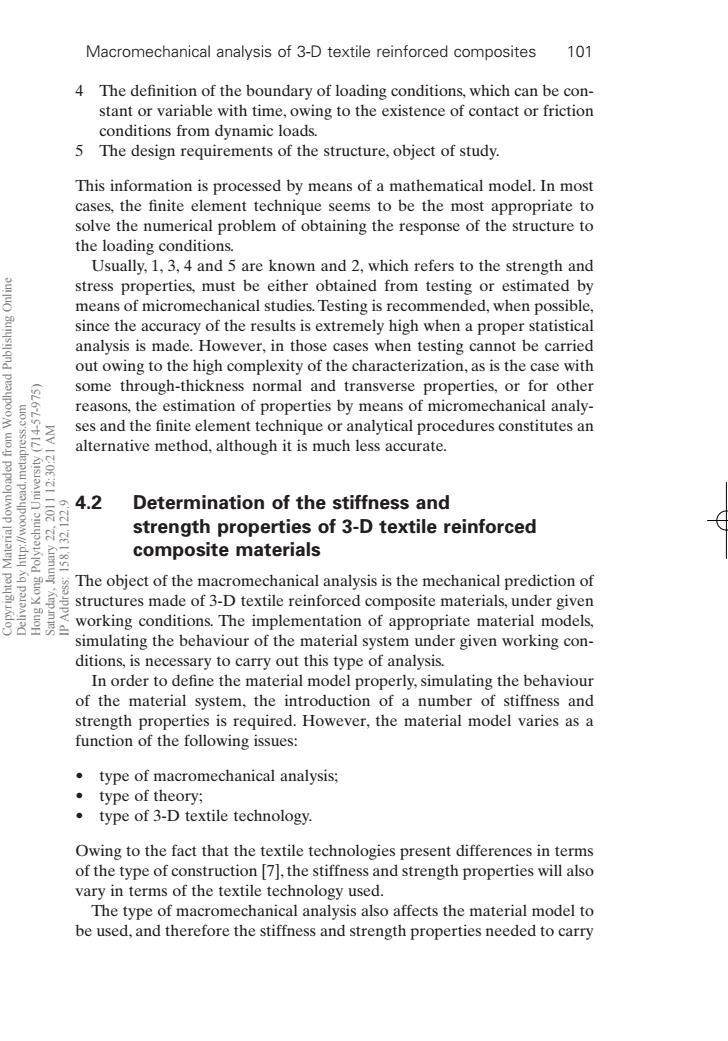正在加载图片...

Macromechanical analysis of 3-D textile reinforced composites 101 4 The definition of the boundary of loading conditions,which can be con- stant or variable with time,owing to the existence of contact or friction conditions from dynamic loads. 5 The design requirements of the structure,object of study. This information is processed by means of a mathematical model.In most cases,the finite element technique seems to be the most appropriate to solve the numerical problem of obtaining the response of the structure to the loading conditions. Usually,1,3,4 and 5 are known and 2,which refers to the strength and stress properties,must be either obtained from testing or estimated by means of micromechanical studies.Testing is recommended,when possible, since the accuracy of the results is extremely high when a proper statistical analysis is made.However,in those cases when testing cannot be carried out owing to the high complexity of the characterization,as is the case with some through-thickness normal and transverse properties,or for other reasons,the estimation of properties by means of micromechanical analy- ses and the finite element technique or analytical procedures constitutes an alternative method,although it is much less accurate. op 4.2 Determination of the stiffness and 号 strength properties of 3-D textile reinforced composite materials The object of the macromechanical analysis is the mechanical prediction of structures made of 3-D textile reinforced composite materials,under given 8 working conditions.The implementation of appropriate material models, simulating the behaviour of the material system under given working con- ditions,is necessary to carry out this type of analysis. In order to define the material model properly,simulating the behaviour of the material system,the introduction of a number of stiffness and strength properties is required.However,the material model varies as a function of the following issues: type of macromechanical analysis; ·.type of theory; type of 3-D textile technology. Owing to the fact that the textile technologies present differences in terms of the type of construction [7],the stiffness and strength properties will also vary in terms of the textile technology used. The type of macromechanical analysis also affects the material model to be used,and therefore the stiffness and strength properties needed to carryMacromechanical analysis of 3-D textile reinforced composites 101 4 The definition of the boundary of loading conditions, which can be constant or variable with time, owing to the existence of contact or friction conditions from dynamic loads. 5 The design requirements of the structure, object of study. This information is processed by means of a mathematical model. In most cases, the finite element technique seems to be the most appropriate to solve the numerical problem of obtaining the response of the structure to the loading conditions. Usually, 1, 3, 4 and 5 are known and 2, which refers to the strength and stress properties, must be either obtained from testing or estimated by means of micromechanical studies. Testing is recommended, when possible, since the accuracy of the results is extremely high when a proper statistical analysis is made. However, in those cases when testing cannot be carried out owing to the high complexity of the characterization, as is the case with some through-thickness normal and transverse properties, or for other reasons, the estimation of properties by means of micromechanical analyses and the finite element technique or analytical procedures constitutes an alternative method, although it is much less accurate. 4.2 Determination of the stiffness and strength properties of 3-D textile reinforced composite materials The object of the macromechanical analysis is the mechanical prediction of structures made of 3-D textile reinforced composite materials, under given working conditions. The implementation of appropriate material models, simulating the behaviour of the material system under given working conditions, is necessary to carry out this type of analysis. In order to define the material model properly, simulating the behaviour of the material system, the introduction of a number of stiffness and strength properties is required. However, the material model varies as a function of the following issues: • type of macromechanical analysis; • type of theory; • type of 3-D textile technology. Owing to the fact that the textile technologies present differences in terms of the type of construction [7], the stiffness and strength properties will also vary in terms of the textile technology used. The type of macromechanical analysis also affects the material model to be used, and therefore the stiffness and strength properties needed to carry RIC4 7/10/99 7:43 PM Page 101 Copyrighted Material downloaded from Woodhead Publishing Online Delivered by http://woodhead.metapress.com Hong Kong Polytechnic University (714-57-975) Saturday, January 22, 2011 12:30:21 AM IP Address: 158.132.122.9